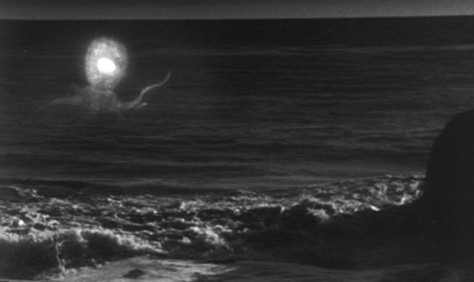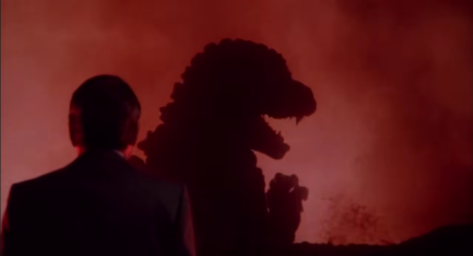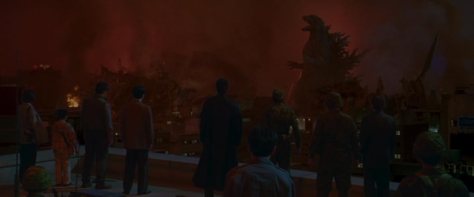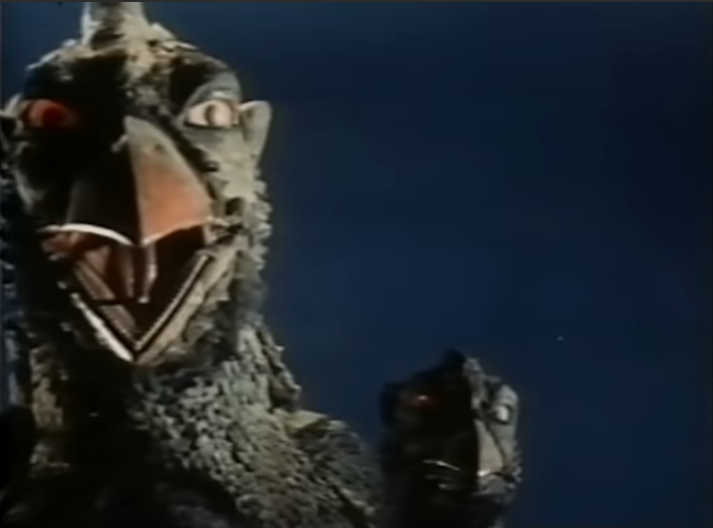Just for completeness’ sake (and maybe to show how my writing technique has grown and/or atrophied over time), I’m going to reprint some reviews I wrote on an earlier website back in the first half of 2014, the 60th anniversary of the Godzilla series. There is a new Godzilla film being released in Japan in July, so maybe this could lead up to me seeing that movie, on the off chance someone sends me by express mail to Japan with enough yen in my pocket to buy a ticket. Unlike Ultraman and Ultra Q, there are no legal ways to stream any of these movies currently (I saw some of them when they briefly appeared on Crackle, and others not mentioned in these reviews are available on Shout Factory‘s site), so if you want to see them for yourself you will probably have to find some DVDs and Blu-Rays.
***
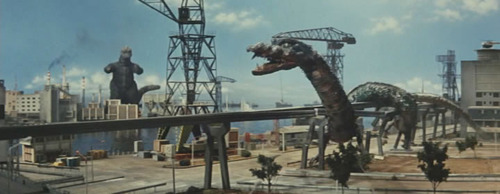
Destroy All Monsters (1968)
The film opens with what is essentially a mini-documentary about the lives of the monster community in MonsterLand, all birds-eye shots of elaborate miniature landscapes and an English voice-over that brings to mind those old Disney nature shows. Aside from being an early example of the really nice wide-shots featuring multiple monsters on screen (something I imagine was some of the most complicated scenes the Toho crew had ever staged), this intro sets up the science fiction utopian vision of the movie – this is basically a whiz-bang sci-fi movie that exists in a world where the existence of giant monsters is a given, which is a really interesting way to go about it. It’s a year of advanced rocket science and nature completely under control, only interrupted by the intervention of even more technologically advanced extraterrestrials.
Most of the movie is that whiz-bang science fiction plot (the two-fisted space pilot lead, the alien stuff, and the super-science are seem to be callbacks to the kind of films that were in theatres at the same time as the original Godzilla), with the monsters more or less acting as walking natural disasters that get in the human characters’ way. I imagine this was because of the previously-mentioned difficulty of staging multiple suit actors, because the human scenes don’t look especially cheap – lots of elaborate sets, shootouts, and Thunderbirds-style miniatures. Normal monster movie logic would say that this is a problem, but everything, while human or monster, barrels ahead pretty quickly, so the film never really gets too dull.
Plus, the all-out bombastic thrills of the monster scenes make it all worth while. The final battle with King Ghidorah not only has about five or six different monsters all getting to do their thing (including surprise all-star Gorosaurus), but even has a ringside announcer doing their entrances. Godzilla, of course, gets the last say on things by kicking in the door of the alien base in Mt. Fuji – payback for spending the rest of the movie in thrall to alien women in silver shawls (am I making this up, or do we several of these movies have their alien threats consist entirely of women? It’s at least also the case in Gamera vs. Guiron. I wonder what the conscious reasoning behind this would be?) It’s all in good fun, though we still get a reminder that no matter how much it seems the monsters are helping us, they are only going after who they know to be the major threat at that time – re-establishing that the kaiju are their own beasts with their own agendas. You know, just so we’re not TOO comfortable with them around, a repudiation of the beginning of the movie.

Godzilla vs. King Ghidorah (1991)
A bit of a glorious mess – this movie is all over in the place, going for dozens of different ideas and not really landing any of them, but still interesting in the attempt. Responding to growing anti-Japanese sentiment in the west in the late 80s with borderline jingoism, as white people from the future go back in time to sabotage an age where Japan dominates economically, it is both confused and confusing. At the very least, the change in directions feel a little less like whiplash because the movie starts out incredibly heightened, even by Godzilla standards – we open in a rapidfire number of scenes that present to us grown men obsessed with dinosaurs and a long-debunked photo is used as evidence that dinosaurs still live.
A little distracted by the Terminator-homaging androids and cameo appearances by the Tom Baker-era Doctor Who time tunnel, we may not notice that this is a movie that is mainly about Japan’s complicated relationship with Godzilla, the figure, and in turn with its own history. In keeping with the Heisei series’ determination to keep him an anti-hero, the film goes back and forth with Godzilla’s role, first a menace that endangers the entire country, then a hero stopping an even greater threat to Japan, and then a menace again. It’s hard not to see this as a struggle with Japan’s own military history – it waffles on what to think of the country’s past militarism (which has multiple faces in the film as a few war veterans, who having survived thanks to proto-Godzilla’s slaughter of an entire platoon of American soldiers in WWII, are responsible for building up Japan’s post-war economy), though it still posits a demilitarized and disarmed future. This is further shown through the eccentric millionaire vet’s personal views on Godzilla, who he can’t help but see as a sort of guardian spirit – and this subplot is concluded pretty astoundingly during Godzilla’s powered-up rampage near the end of the movie
The same millionaire, in an earlier scene, reveals to the Japanese government that he has built his own nuclear submarine, suggesting that they use it to recreate Godzilla. Although its not a major part of the film, there is some nuclear weapons subtext in there as well – it may seem a kind of cheat in order to bring Godzilla back for his battle, the fact that he ended up being created even after being removed from the atomic testing sites posits a kind of inevitability to his existence. After all, nuclear weapons didn’t stop being a concern after the time of the original film – Pandora’s box is open, and no matter what we think we can do to stop it, it will always remain a threatening undercurrent. There is the intimation that the future will be better – we go from one generation building nuclear weapons, to the next generation rejecting them, to the next generation abolishing them – but it still gives you pause at what we did before we could get there.
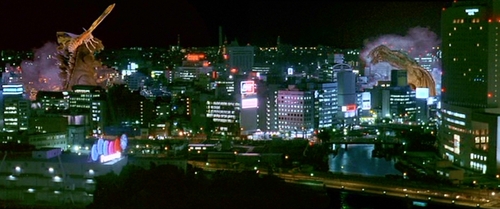
Godzilla, Mothra, and King Ghidorah: Giant Monsters All-Out Attack (2001)
This movie is not so ambiguous about its position on Japanese history and militarism – it’s a battle of karmic forces acting in relation to human action, not so far removed from the ideas Shusuke Kaneko used previously in his Gamera trilogy (which is probably why they hired him for this.) Godzilla no longer stands just in for the atomic weaponry used against Japan, but also the vengeful spirits of the countless victims of Japanese imperialism – an acknowledgement of all sides of a tragedy, and Japan’s own bloody attempts at conquest. The forces opposing Godzilla, now more menacing than ever with his soulless eyes and gleeful destructiveness, are nature spirits who can be summoned by humankind, but don’t necessarily fight for them – they are connected to the land, and to ancient traditions, and in their earlier scenes accidentally end up offing groups of disrespectful young hooligans ala Jason Vorhees, just to get the point across. Like in the Gamera movies, there is a place for humans in this conflict, but as is often pointed out again and again, most are not engaged with their history in the slightest, and create a culture where our past can come back to haunt us.
GMK is certainly attempting to return the series to the tone of the original movie, bringing back the terrifying force of nature version of Godzilla, putting a lot of focus on the ground-level effects of the monsters, and even including some straight riffs on scenes from that movie (including Godzilla’s first appearance behind a hillside and scenes of wounded people in a hospital.) Kaneko goes out of his way to undermine any enjoyment we might have in the levelling of the cities – there are always fleeing people always in view – and even the battles with the “good” monsters makes sure to show the collateral (once again, very similar to Gamera, but going farther.) I can’t really say the imagery is straight-up horror as it was in the original, (they certainly go for a lot of dark humour along the way), but it’s certainly not the violence-against-miniatures-for-violence’s-sake that much of the later films became – there are stakes, and there are consequences.
At the same time, the reinterpretation of Godzilla somewhat opposes the original – which, in some interpretations, was at least partially a celebration of the new Japanese SDF. Not here – aside from the notion of Godzilla as vengeful spirit, we see that not only are the events of the original covered-up (the adversarial position to history again), the military shown as overconfident with their latest weaponry (which is first introduced as tools for search-and-rescue operations rather than military use), and the government is slow to act in the face of a crisis. The latter of those is more or less in line with the 1954 movie, but this one obviously goes much farther in its distrust of authority. The military is more or less redeemed through the Commander, who is one of the few people who refuses to disengage with what came before and is ultimately the one to take down Godzilla when even the trio of guardian spirits fail – but the idea remains that human violence, and not just the threat of advanced weaponry, is the real underlying concern with these movies.
